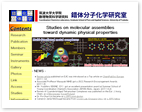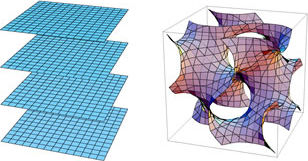|
|
 |
Electronic structure theory. Computational material science. To reveal and predict the electronic and geometric structures of new carbon related materials based on the quantum theoretical approaches. Theoretical prediction of electronic properties of nano-scale structures on surfaces and interfaces. |
|
|
 |
Research on quantum transport phenomena in mesoscopic and nanoscale systems.
Explore new properties of atomic layer systems (for example, graphene) and
fundamental technology for the device applications.
Observation and manipulation of flaxoid of small superconductors.
|
|
|
 |
Solid state physics of many-electron systems in semiconductor nanostructures by spectroscopic methods in high magnetic fields at low temperatures. |
|
|
 |
Theory on quantum transport and non-equilibrium dynamics in semiconductor nanostructures. Quantum coherence in a hybrid system and possible application to quantum computing. |
- Hiroki Oshio
- Takuya Shiga
|
 |
Coordination Chemistry on multinuclear metal complexes: Design and syntheses of multifunctional metal complexes. |
- Kazuya Saito
- Yasuhisa Yamamura
- Mafumi Hishida
|
 |
Physical chemistry of structure and properties of molecular aggregates (soft matter, organic/low-dimensional conductors, molecular dynamics in crystal and phase transitions). |
- Tatsuya Nabeshima
- Takashi Nakamura
- Ryota Matsuoka
- Yusuke Chiba
|
 |
Design and synthesis of functional organic compounds, organic and inorganic hybrid supramolecular complexes and molecular assemblies, and biofunctional host molecules. |
